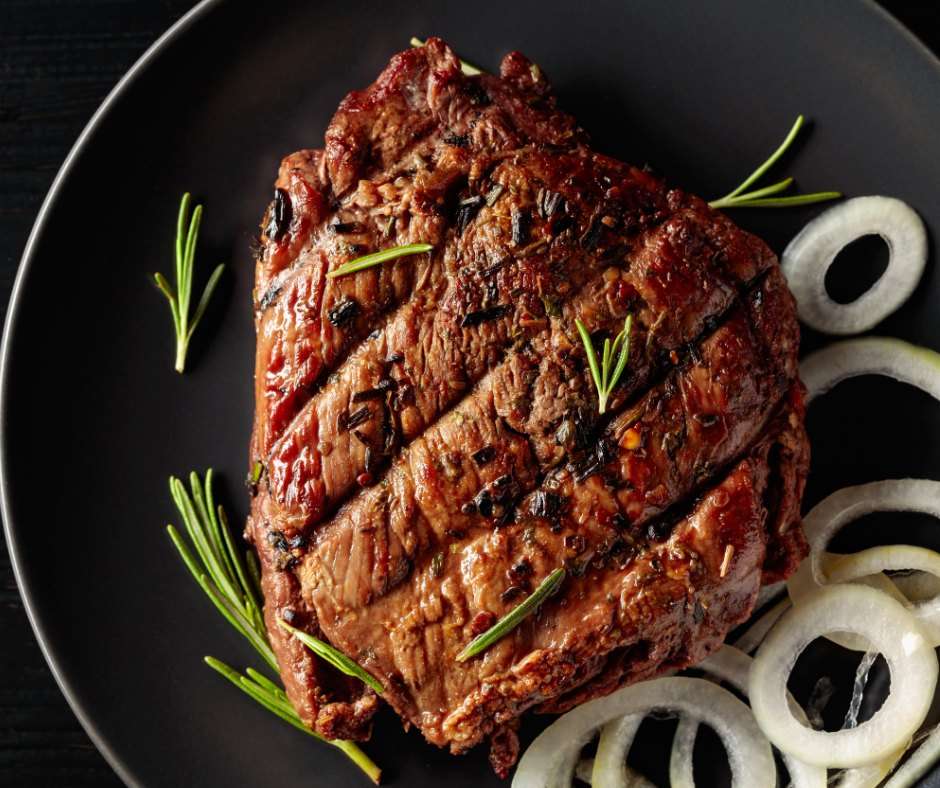
Red Meat is not off-limits like once thought!
For many many years it was preached to us to lay off the red meat. Well, it all was a farce! If the beef is grass-fed or pasture-raised, this meat has so many benefits!
Let’s first go over the false information that was fed to us. And then I will explain how grass-fed or pasture-raised beef is the source you want.
I want to explain a few things about beef.
Lie 1: Beef is bad for your diet.
In 2012, The Pennsylvania State University released the Beef in an Optimal Lean Diet (BOLD) study to show that lean beef can be part of a heart-healthy diet. BOLD showed that LDL-cholesterol (the “bad” kind) decreased 10 percent in study participants who consumed lean beef daily. This came as no surprise to me, as grass-fed beef is a good or excellent source of 10 essential vitamins and nutrients and packs a powerful punch of ~25 grams of protein per 3-ounce serving. My husband and I enjoy beef multiple times a week – it fuels our busy lives and keeps our bellies full while providing us with valuable nutrition.
Lie 2: Cattle are hurting the climate.
When it comes to science, climate and agriculture, the Environmental Protection Agency is our best source of science and that agency has stated, consistently, that cattle are responsible for less than three percent of U.S. greenhouse gas emissions. Comparatively, transportation and industry are both roughly 10 times that amount so when we get down to the numbers, it’s quite a stretch to blame climate change these creatures. Out in the pasture, cows are contributing to conservation by grazing on lands that mostly aren’t suitable for growing crops, thereby converting human inedible cellulose into nutritious protein while storing carbon in the soil through carbon sequestration. I’m not demonizing cars or boycotting travel, but I am asking that we take a more realistic look at the behaviors in our lifestyles that have significant impacts on our climate.
Lie 3: Beef is only for steak and burger lovers.
Even though those are the most known types of beef, there’s so much more to beef than just steak and burgers! Don’t be intimidated by the cuts you see on the grocery store shelves. My husband and I buy a quarter of a cow every year and stock it in the freezer for a year. Why not try stew meat for kabobs or a hearty roast on a cold evening? I love making crock pot recipes because they are so easy to make. When you come home, the house smells so good and dinner is done!
So, there you have it – three myths effectively debunked!
How is Grass Fed or Pasture-Raised Beef Different?
1. Potential Cancer Fighter
There are actually 16 different types of CLA, each providing a unique and highly important health benefit. CLA has been shown in numerous animal studies since 1994 to promote health and fight disease.
From cancer fighting to weight loss, CLA is touted worldwide as a “must have” in your diet for optimal health today and into tomorrow. Studies on conjugated linoleic acids show their ability to prevent and treat cancer as well as obesity, diabetes and cardiovascular diseases.
CLA sources have proved their ability as cancer-fighting foods in multiple animal studies. As a study published in the journal Cancer suggests, CLA is unique in the fact that it comes from animal sources since the majority of natural, anticancer substances are of plant origin. Additionally, animal-derived CLA’s “anticancer efficacy is expressed at concentrations close to human consumption levels.”
In 2000, a Finnish study published in the journal Nutrition and Cancer demonstrated that there may also be anticarcinogenic effects of CLA for humans. In this study, women who had the highest levels of CLA in their diets had a lower risk of breast cancer than those with the lowest levels of CLA.
The anticancer research for CLA and humans will hopefully continue because it looks very promising so far.
2. Helps Reduce Heart Disease Risk
Research indicates that an herbivore diet for livestock is linked to human health and can protect meat from protein oxidation and lipid peroxidation that’s linked to inflammation and heart disease. This is in large part due to the phytochemicals that are present in a grass-fed diet.
The main reasons why grass-fed beef can benefit heart health include:
- Less overall fat and unhealthy fat
- Lower levels of dietary cholesterol
- Higher levels of heart-healthy omega-3 fatty acids
- More CLA
- More heart disease-fighting antioxidant vitamins, like vitamin E
When you take into account this impressive nutrition content, you can easily understand why eating grass-fed beef burgers and sirloins instead of conventional options can help reduce the risk of cardiovascular disease.
3. Can Improve Blood Sugar
Getting enough healthy fats in your diet is extremely helpful to keep your blood sugar at a healthy level. Research published in the Journal of Endocrinology and Metabolism in 2016 looked at the effects of the healthy fat CLA on insulin sensitivity in obese children.
The randomized, double-blinded and placebo-controlled study found that 37 percent of the patients treated with CLA exhibited improvements in insulin sensitivity. In addition, muscle biopsies of the subjects treated with CLA showed an up regulation of the protein molecule IRS2 that mediates the effects of insulin on the body.
Clearly, the benefits of grass-fed beef nutrition are not just for adults. These results in children are also meaningful for adults looking to keep their blood sugar under control to ward off diabetes, heart disease and metabolic syndrome.
I’m glad I got to beef-up your knowledge on this post!
Adrienne
xo
Looking for some help to help you reverse your MS or autoimmune symptoms as soon as possible?
Cookbook – Nourish Your Way to Health
Paperback book – The Path to Reverse Multiple Sclerosis
#reverse MS
#healing is possible
#MS warrior
#Heal autoimmune disease
